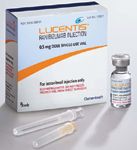Seniors can set new sights with this biologic
A new biologic, ranibizumab (Lucentis, Genentech), has just been cleared for age-related macular degeneration (AMD). A study of Medicare patients 65 years of age and older found that AMD increased substantially-from 5% to 27%-between 1991 and 1999. The American Academy of Ophthalmology estimates that more than 1.75 million Americans have AMD, with seven million more having earlier stages of the disease.
A new biologic, ranibizumab (Lucentis, Genentech), has just been cleared for age-related macular degeneration (AMD). A study of Medicare patients 65 years of age and older found that AMD increased substantially-from 5% to 27%-between 1991 and 1999. The American Academy of Ophthalmology estimates that more than 1.75 million Americans have AMD, with seven million more having earlier stages of the disease.

Engineered as a humanized antibody fragment, ranibizumab is a VEGF-A receptor antagonist. It is the first anti-VEGF treatment approved for AMD that inhibits the binding of all five VEGF-A isoforms; thus, it has the potential to completely inhibit pathological endothelial cell proliferation, vascular leakage, and new blood vessel growth in the eye.

In two phase III studies with ranibizumab, 95% of patients treated monthly were able to maintain their vision for one year (compared with 60% of patients who received control treatment). Furthermore, approximately one-third of patients experienced visual improvements, maintaining these visual gains for at least 24 months in one study. "This is a big improvement over other AMD-approved drugs," stated pharmacist Richard Fiscella, a clinical professor in the department of pharmacy practice at the University of Illinois College of Pharmacy in Chicago. "Patients with AMD are experiencing favorable responses to treatment."
To minimize systemic exposure and ensure that the drug is delivered precisely to the site where its actions are needed, ranibizumab is administered into the eye via intravitreal injections by ophthalmologists. Genentech recommends monthly treatments. Treatment may be reduced to every three months after the first four injections, if monthly administration is not possible. However, dosing every three months is not as effective as monthly treatments.
In clinical studies, the most common adverse reactions were conjunctival hemorrhage, eye pain, vitreous floaters, increased intraocular pressure, and intraocular inflammation.
Patients should be warned that endophthalmitis (inflammation of the interior of the eye, caused by infection or trauma) and retinal detachments may occur as a result of intravitreal injections, and patients should be monitored during the week following their injections. If the treated eye becomes red, sensitive to light, painful, or develops visual changes, patients should seek immediate medical attention from their ophthalmologist. Additionally, elevated intraocular pressure may occur within 60 minutes of receiving the injection; therefore, ophthalmologists will monitor intraocular pressure as well as optic nerve head perfusion after drug administration.
THE AUTHOR is a medical writer based in Pennsylvania.
